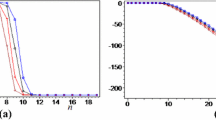Abstract
Let \(\mathcal{H}(f)(x)=\int_{(0,\infty)^{d}} f(\lambda) E_{x}(\lambda) d\nu(\lambda )\), be the multivariate Hankel transform, where \(E_{x}(\lambda)=\prod_{k=1}^{d} (x_{k} \lambda_{k})^{-\alpha _{k}+1/2}J_{\alpha_{k}-1/2}(x_{k} \lambda_{k})\), with dν(λ)=λ 2α dλ, α=(α 1,…,α d ). We give sufficient conditions on a bounded function m(λ) which guarantee that the operator \(\mathcal{H}(m\mathcal{H} f)\) is bounded on L p(dν) and of weak-type (1,1), or bounded on the Hardy space H 1((0,∞)d,dν) in the sense of Coifman-Weiss.
Similar content being viewed by others
References
Alexopoulos, G.: Spectral multipliers on Lie groups of polynomial growth. Proc. Am. Math. Soc. 120(3), 973–979 (1994)
Bergh, J., Löfström, J.: Interpolation Spaces: an Introduction. Springer, Berlin (1976)
Betancor, J.J., Castro, A.J., Curbelo, J.: Spectral multipliers for multidimensional Bessel operators. J. Fourier Anal. Appl. 17(5), 932–975 (2011)
Betancor, J.J., Dziubański, J., Torrea, J.L.: On Hardy spaces associated with Bessel operators. J. Anal. Math. 107, 195–219 (2009)
Bloom, W.R., Xu, Z.: Fourier multipliers for L p on Chébli-Trimeche hypergroups. Proc. Lond. Math. Soc. 80(3), 643–664 (2000)
Christ, M.: L p bounds for spectral multipliers on nilpotent groups. Trans. Am. Math. Soc. 328(1), 73–81 (1991)
Coifman, R., Weiss, G.: Extensions of Hardy spaces and their use in analysis. Bull. Am. Math. Soc. 83(4), 569–645 (1977)
Duoandikoetxea, J.: Fourier Analysis. Am. Math. Soc., Providence (2001)
Dziubański, J., Preisner, M.: Multiplier theorem for Hankel transform on Hardy spaces. Monatshefte Math. 159, 1–12 (2010)
Gosselin, J., Stempak, K.: A weak-type estimate for Fourier-Bessel multipliers. Proc. Am. Math. Soc. 106(3), 655–662 (1989)
Garrigós, G., Seeger, A.: Characterizations of Hankel multipliers. Math. Ann. 342(1), 31–68 (2008)
Gasper, G., Trebels, W.: Necessary conditions for Hankel multipliers. Indiana Univ. Math. J. 31(3), 403–414 (1982)
Haimo, D.T.: Integral equations associated with Hankel convolutions. Trans. Am. Math. Soc. 116, 330–375 (1965)
Hebisch, W., Zienkiewicz, J.: Multiplier theorems on generalized Heisenberg groups II. Colloq. Math. 69(1), 29–36 (1995)
Hörmander, L.: Estimates for translation invariant operators in L p spaces. Acta Math. 104, 93–140 (1960)
Lebedev, N.N.: Special Functions and Their Applications. Dover, New York (1972)
Martini, A.: Algebras of differential operators on Lie groups and spectral multipliers. Ph.D. Thesis, Scuola Normale Superiore Pisa (2009)
Mauceri, G., Meda, S.: Vector-valued multipliers on stratified groups. Rev. Mat. Iberoam. 6(3–4), 141–154 (1990)
Müller, D., Stein, E.M.: On spectral multipliers for Heisenberg and related groups. J. Math. Pures Appl. 73, 413–440 (1994)
Sikora, A.: Multivariable spectral multipliers and analysis of quasielliptic operators on fractals. Indiana Univ. Math. J. 58(1), 317–334 (2009)
Stein, E.: Topics in Harmonic Analysis Related to the Littlewood-Paley Theory. Princeton University Press, Princeton (1970)
Stein, E.: Singular Integrals and Differentiability Properties of Functions. Princeton University Press, Princeton (1970)
Titchmarsh, E.C.: Introduction to the Theory of Fourier Integrals. Clareoton Press, Oxford (1937)
Triebel, H.: Interpolation Theory, Function Spaces, Differential Operators. North-Holland, Amsterdam (1978)
Uchiyama, A.: A maximal function characterization of H p on the space of homogeneous type. Trans. Am. Math. Soc. 262(2), 579–592 (1980)
Watson, G.N.: A Treatise on the Theory of Bessel Functions. Cambridge University Press, Cambridge (1944)
Wróbel, B.: Multivariate spectral multipliers for tensor product orthogonal expansions. Monatshefte Math. 168(1), 125–149 (2012)
Acknowledgements
The authors would like to thank Alessio Martini for discussions on spectral multipliers, Adam Nowak and Tomasz Z. Szarek for their useful remarks, Jacek Zienkiewicz for pointing out to us Example 5.1, and the referees for their helpful comments and suggestions.
Author information
Authors and Affiliations
Corresponding author
Additional information
Communicated by Hans G. Feichtinger.
The research was partially supported by Polish funds for sciences, grants: N N201 397137 and N N201 412639, MNiSW, NCN, and research project 2011/01/N/ST1/01785, NCN.
Appendix
Appendix
Proof of (1.14)
The proof of Theorem 1.3 actually shows that

Now, using (1.13) we write n u (λ)=Ξ(λ)(λ 1+⋯+λ d )iu, so that \(n_{u}(\lambda _{1}^{2},\ldots,\lambda_{d}^{2})=m_{u}(\lambda)\). We claim that
Using (5.2) and combining it with (5.1), we get \(\|L^{iu}\|_{L^{1}(X)\to L^{1,\infty}(X) }\leq C_{\varepsilon }(1+|u|)^{Q/2+\varepsilon}\). Since \(\|L^{iu}\|_{L^{2}(X)\to L^{2}(X)}=1\), using the Marcinkiewicz interpolation theorem, see, e.g. [8, (2.2) p. 30], together with a duality argument, we obtain (1.14) for all 1<p<∞.
Now, we sketch the proof of (5.2). Let \(B_{p,q}^{s}\), 1≤p,q≤∞, s≥0, be the Besov space, as defined in [2, p. 141]. It is known, see [2, Theorem 6.2.4 (10), p.142], that \(B_{\infty, q}^{s}\) is the real interpolation space of the spaces \(\mathcal{L}_{s}^{\infty}=\mathcal{L}_{s}^{\infty}(\mathbb{R}^{d})\), precisely
Moreover, from [2, Theorem 6.2.4 (9), p.142], we have
For general Banach spaces X and Y, one has
see [24, Theorem (g), p. 25]. Now, it is straightforward to check that (5.2) is true for s=2n, \(n\in\mathbb{N}\cup\{0\}\). Using the latter observation, (5.4), (5.3) with q=1, and (5.5) with \(X=\mathcal{L}_{2n}^{\infty}\), \(Y=\mathcal{L}_{2n+2}^{\infty}\), for s=(1−θ)2n+θ(2n+2), 0<θ<1, we obtain

□
The following example shows that in the multivariable case for functions n(λ) supported in A 1/2,2 the Sobolev norms \(\| n\|_{W_{2}^{s}(\mathbb{R}^{d})}\) do not control the Sobolev norms \(\| m\|_{W_{2}^{s'}(\mathbb{R}^{d})}\) (even for certain range s′ smaller than s) where n and m are related by (1.8).
Example 5.1
Let F(x,y) be a function defined on \(\mathbb{R}\times\mathbb{R}^{\ell}\) and s>0. Observe that
Moreover, it can be shown that for every r>0 there is a constant C>0 such that for f supported in the interval \((\frac{1}{2}, 2 )\) one has
where \(\tilde{f}(x)=f(x^{2})\).
Let \(\varphi\in C_{c}^{\infty}(\frac{1}{2},\frac{3}{2} )\) and \(\psi\in C_{c}^{\infty}(\mathbb{R}^{\ell})\), ψ(y)=0 for \(|y|>\frac{1}{2}\), \(\varphi, \psi\not\equiv0\). Fix ε∈(0,1), R>1 and define the functions n R (x,y) on \(\mathbb{R}\times\mathbb{R}^{\ell}\) by
The functions n(x,y) are supported in A 1/2,2, near the vector e 1. Moreover,
From (5.6) and (5.8) we conclude that
Set \(m(x,y)=m_{R}(x,y)=n_{R}(x^{2}, y_{1}^{2},\ldots,y_{\ell}^{2})=f(x^{2})g(y_{1}^{2}, y_{2}^{2},\ldots,y_{\ell}^{2})= \tilde{f}(x)\tilde{g}(y)\). The functions m R are supported near the vectors ±e 1. By (5.7) for s′>0 and R large we have
Clearly,
Now, (5.6) combined with (5.9) and (5.10) imply that
Summarizing,
which clearly tends to infinity as R→∞ provided that s′>s−(1−ε)ℓ/4.
Rights and permissions
About this article
Cite this article
Dziubański, J., Preisner, M. & Wróbel, B. Multivariate Hörmander-Type Multiplier Theorem for the Hankel transform. J Fourier Anal Appl 19, 417–437 (2013). https://doi.org/10.1007/s00041-013-9260-y
Received:
Revised:
Published:
Issue Date:
DOI: https://doi.org/10.1007/s00041-013-9260-y



